
Recently Remodeled Heritage Farm Highlights Sustainable Living and Natural Charm
The renovations have transformed the farm into a more purposeful, low-maintenance, and environmentally conscious experience.
By – Tina Deines
With warm, red locks framing her face and a pair of horns pointing out, Sophia the highland cow is a sight to behold as she chomps on her Timothy hay alongside her bovine buddies Stewie and Brora.
This adorable trio is just one of many exciting additions awaiting guests at the Heritage Farm, which reopened on April 22 after about two years of construction. The $14 million project was funded by the 1/8 cent gross receipts tax approved by Albuquerque voters, which went into effect in 2016.
“We're very excited to welcome guests back to the Heritage Farm,” says ABQ BioPark Associate Director Matthew Peterson. “The idea is to connect guests with some past and present agricultural practices and present a demonstration as to how people can raise their own food crops or care for domestic animals at home, too. So we’re really trying to connect our guests with our mission of fostering meaningful connections between people and nature.”
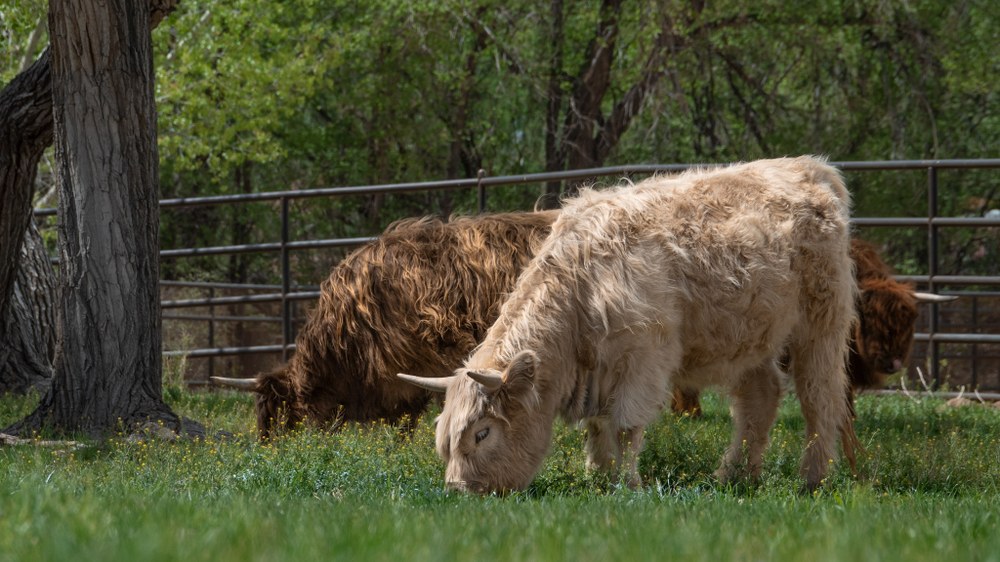
The new Highland cattle, featuring Brora in the foreground, graze in a field surrounded by greenery at Heritage Farm.
New Faces, New Spaces
The three new highland cattle, which arrived in August 2024, represent just a few of the new faces awaiting people at the farm. Other newcomers include Esmeralda and Julio, a pair of miniature donkeys; a trio of playful Nigerian dwarf goat sisters named Phoebe, Piper and Prue; and a group of new chickens that represent four breeds.
Of course, the farm is also home to some veterans, including Bugz the painted horse; a group of Navajo-Churro sheep; and turkeys Tawd, Lilly, Rose, Daisy and Tulip.
All of these animals are benefitting from housing upgrades, which will strengthen welfare and help animal care staff to be more effective in their daily routines.
For instance, newly built high-tech horse and cattle barns boast a number of features like fans to keep the animals cool in the summer and automated “water fountains” that provide fresh, cool drinking water on demand.
Plus, specially designed flooring in the animals’ private stalls will help with shock absorption for these large hoofed animals — an American painted horse like Bugz can weigh in between 950-1,200 pounds, with female highland cows weighing about the same and bulls sometimes topping out around 2,000 pounds. All of this weight can put stress on joints.
“This flooring is supposed to be cushiony enough for them so they're not standing on hard concrete and it will help prevent joint and arthritis problems,” says Jessica Dragon, master farmer at the Heritage Farm.
Each yard also includes about 1 acre of pasture for grazing, and an additional shared pasture is being used for rotational grazing of horses, cattle, sheep and donkeys. This type of grazing not only offers new enrichment opportunities for the animals as they explore new areas and smells, but it is also a more conservation-minded approach to the practice, as occasionally moving the cattle and horses to this shared space will give the grasses and other plants in their personal pastures time to recover.
“This is really exciting and a great conservation win,” Peterson says. “It’s a very sustainable way of pasturing.”
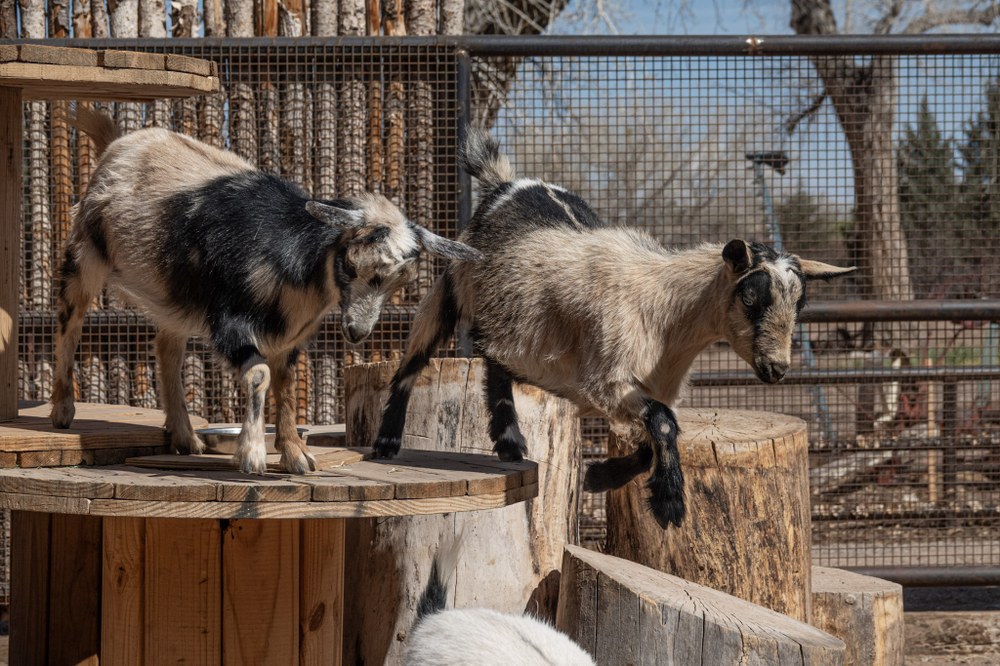
Two of the farm's new Nigerian dwarf goats, Piper, left, and Phoebe, right, play on top of their wooden platform at Heritage Farm.
Each pasture also includes drinking stations, which tap into the water table below ground. And both the cattle and Bugz have a dry lot, or an additional space where the natural dirt surface has been maintained. Putting animals on a dry lot is yet another way to let pastures rest and to help prevent landscape damage during particularly wet or dry conditions.
But those aren’t the only nifty new features for the cattle and Bugz. For instance, the highland cattle have what Dragon describes as “top-of-the-line rotating cattle brushes,” which detect the animals when they approach and start spinning to get to their itches. These scratch pads can even rotate to different angles to help with some of those hard-to-reach spots. Another brush in the cattle yard releases fly spray when activated by a cow or bull, helping to manage these insects, which can irritate and stress cattle.
The cattle and horse barns also have new walk-in chutes that will help staff bathe the animals and more easily perform healthcare procedures. Each of the barns is equipped with warm water, a new feature that will be useful in treating any issues that may pop up — for instance, warm water is helpful in cleaning wounds.
“That’s been revolutionary on the farm,” Dragon says of the new warm water access at the barns.
Dragon’s also excited about new drainage behind each barn, which will help animal staff more easily hose these areas down to keep surfaces clean.
The cattle and horse aren’t the only animals to get home upgrades, however. All of the yards at the small animal barn have been greatly expanded as well, giving residents there a lot more space to move around and explore. This has introduced more opportunities for staff to place enrichment items within each habitat. Plus, new “privacy fencing,” a system that includes wooden fence posts that alternate with open spaces where guests can view the animals through wire fencing, increases animal comfort since many of the residents of the small animal barn are prey species that don’t like being exposed.
“It's been a huge change and you can just tell with the space and all the new accommodations just how much more easygoing the animals are,” Dragon says of all the new animal upgrades across the farm.
An Edible Landscape
The Heritage Farm’s crop areas have also undergone some exciting new changes.
For instance, the farm’s acequia, which is used to irrigate the adjacent orchards and vineyards, has been concreted.
“That obviously helps conserve some water by not allowing it to get absorbed into the ground,” says Master Farmer Janel Titzl. “And then it also increases flow and everything.”
Other water conservation efforts include the addition of several 3,000-gallon rainwater collection tanks, which will be used for supplemental watering, and an upgraded automated drip irrigation system in the vineyard, which will help conserve staff time and water.
Meanwhile, Titzl estimates that the crop planting space is at least five times bigger than before, with the longest beds — five of them — stretching to 98 feet long each. Here, staff are growing veggies like kale, collard greens, lettuces and spinach.
The garden also incorporated perennial beds for the first time with crops like asparagus, artichokes, raspberries and golden currents in the mix. Many of the crops grown at the farm are used to supplement animal diets across the BioPark.
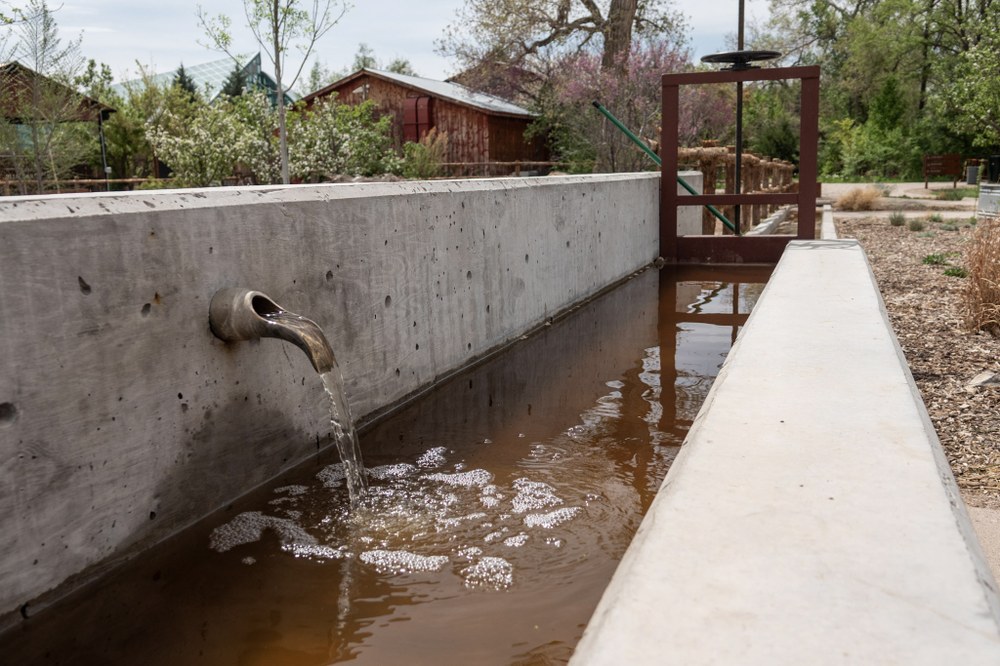
Water flows through a new concrete acequia at Heritage Farm.
Plus, a new “fairy garden” features a selection of edible and medicinal plants like yarrow and lemongrass along with pollinator-friendly flowers. An adjacent container garden was also added to help visitors imagine what is possible for their own backyard plantings.
The cattle yard might also soon be home to a cottonwood forest, which will help provide shade for the animals, as staff recently did a “pole planting” of 50 cottonwood branches. This planting method consists of soaking smaller branches and then putting them straight into the ground where they soak up water from below. With luck, these poles will grow into full-fledged trees.
“In the desert environment, shade is always great to have,” Titzl says. “And then it should potentially reduce the amount that we even have to water in the pastures. It will help provide habitat for wildlife as well.”
Staff also planted new apple trees in the orchard. Some of these are growing using a special technique called espalier planting, which involves training the trees to grow flat against a trellis, creating a structured, two-dimensional “flat” shape that makes it easier for staff to care for the plants and collect fruit. Espalier planting also helps to conserve space, as it prevents trees from getting too bushy.
Some of the other trees in the garden include fig, pear, quince, apricot, plum, cherry, and pecan.
“Much of the farm is like an edible landscape,” Peterson says. “It'll be really neat once many of those trees get established and start to produce various fruits and nuts.”
Self-Sustaining Features
According to Peterson, the farm’s new design was very intentional in creating a space that was lower maintenance and more conservation-minded. For instance, the rainwater tanks and a more efficient acequia will aid in water conservation. Meanwhile, other small decisions like utilizing more mulch throughout the planting spaces will help reduce watering, as it aids in moisture retention. Mulch also helps suppress weeds naturally, eliminating the need for pesticides.
Titzl adds that companion planting on the farm helps to naturally repel destructive pests. For instance, garlic, chives, green onions and marigolds all attract beneficial pollinators while detracting unwanted insects.
Other Additions
If you’re a fan of the old cider barn, don’t worry — it hasn’t gone anywhere and retains its old aesthetic. However, it’s been upgraded to increase efficiency and bring it up to 21st century food grade standards, Peterson says. This will be handy for the annual Cider Festival. Staff harvest about 9,000-10,000 pounds of apples each fall, which are pressed inside the barn to make cider for this annual event.
And if you’re looking to spend some extra time at the farm, perhaps listening to Bugz whinny or simply enjoying immersing yourself in the edible landscape, there are a number of new places to sit and take it all in. One of these areas is an outdoor classroom for children where they can reflect on what they saw during their visit. And a new nature engagement area encourages kids to climb to the top of a little hill where a huge "nest” gives them a bird’s eye view of the entire farm.
Plus, staff are hoping to introduce some of the farm’s residents to guests as “ambassador animals.” Dragon says the donkeys are the first animals slated to take on this role, and they may be followed by the goats. Staff will take ambassador animals for walks around the farm, allowing visitors to touch and interact with them and answering any questions they may have. This is similar to the ambassador animal program at the Zoo, which introduces people to animals like owls and llamas.
“Ambassador animals are just another great way to connect our guests with the amazing work we do as far as animal care and welfare,” Peterson says. “I think people really get to connect on a deeper level when they have those intimate interactions with the animals out at the farm.”
The farm also added about 170 parking spaces, including 88 that are accessible.
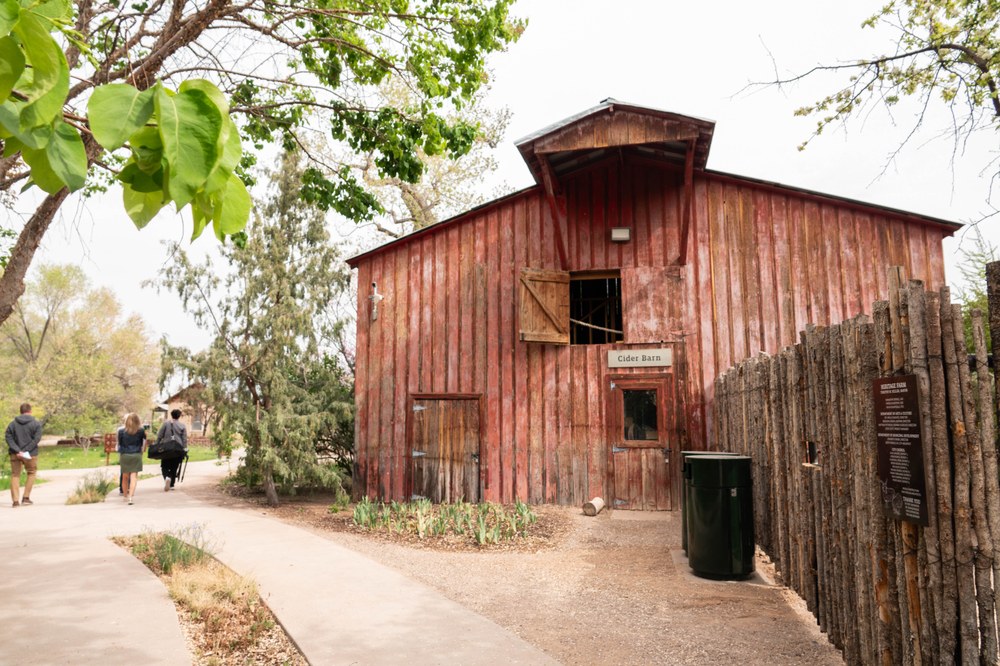
Visitors walk past the upgraded cider barn on the new, paved pathways within Heritage Farm.
Meet the Farm’s New Animals
Highland Cattle
Male Stewie and females Sophia and Brora arrived together in August 2024. They had previously lived at American Highlands Ranch in northern Colorado. Sophia, with locks of red, is the leader of the group, according to Dragon.
“She's queen bee,” Dragon adds. “I would say she’s the friendliest and the most eager to come up and get pets and scratches. She's also extremely smart and picks up on her training very fast.”
Meanwhile, Dragon says Brora, who dons a white coat, is more like a princess.
"She's kind of like, ‘I'll let you love me and give attention but it has to be on my terms,’” Dragon laughs. “She may be a little standoffish at first but she warms up really quick.”
Stewie, the lone male and the smallest of the group, is what Dragon describes as a “rowdy teenage boy.” However, this little redhead gets put in check by his female friends.
Fun fact: The highland cattle enjoy foraging for cookies that care staff put in their puzzle balls and hide around their space.
Miniature Donkeys
Male Julio and female Esmeralda arrived at the Heritage Farm in January 2024. Previously, they had lived with an elderly couple at a farm in El Rito, NM. Though they were well loved there, the couple had become unable to provide them with the care they needed.
“Julio is definitely the sweeter one, a little more weary, kind of like ‘I'm gonna follow her’ kind of guy,” Dragon says. “Esmeralda’s definitely the leader of the two. She's very brave and like, ‘I'm gonna do what I want.’ She's a little sassy.”
This duo is known for being easygoing, and that’s why they’ll serve as the farm’s first education ambassador animals, going on walks and meeting guests.
“They are just like the sweetest, easiest animals to work with,” Dragon says.
Fun fact: A male donkey is called a Jack while a female is called a Jenny.
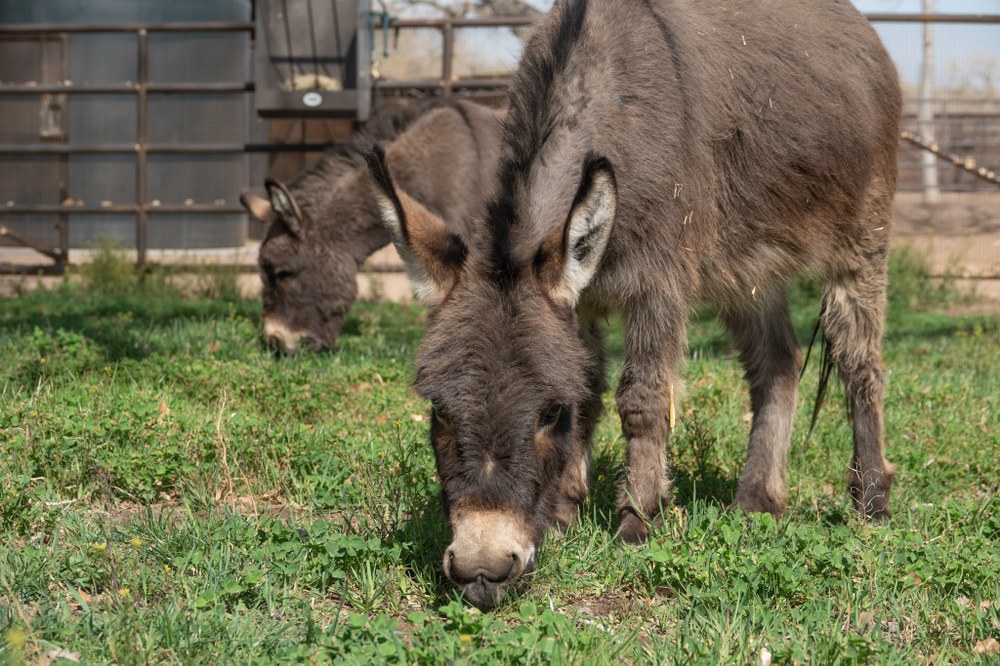
The two new miniature donkeys graze on a green field in Heritage Farm.
Nigerian Dwarf Goats
This trio of sisters is approximately a year old and came to the BioPark from Prairiewood Ranch in Edgewood in July 2024.
These rambunctious ladies love interacting with people, making them possible candidates as ambassador animals in the future.
“They're super friendly and they're really, really smart,” Dragon says of the girls. “We’ll give them puzzle toys for enrichment and they'll figure them out so quick.”
In fact, the goats learned recall — coming to their keeper with the jingle of a key — in about a week.
“They're very impressive and they're just so sweet,” Dragon says. “They play fight like how sisters would — they’ll like head butt each other and then you'll catch them cuddling. They’re just super close to each other.”
Piper is the leader of this group, while Prue is more reserved but is slowly coming out of her shell. Phoebe is like the middle child, Dragon says.
“She's like, ‘I'm just here for a good time. Whatever you guys do, I'll do.’ But they're all very sweet in their own ways.”
Fun fact: Nigerian dwarf goats are originally from West Africa, but now live in a variety of habitats and climates across the world.
Chickens
The Heritage Farm also welcomed a new group of chickens that added four new breeds to the flock: Dominique, mystic onyx, golden Polish and lavender orpington. Altogether, the chicken flock is now 28 strong and represents eight stunning breeds.
Fun fact: The golden Polish is a flashy chicken breed that dons a regal crest on its head. Some even have a beard and muffs.
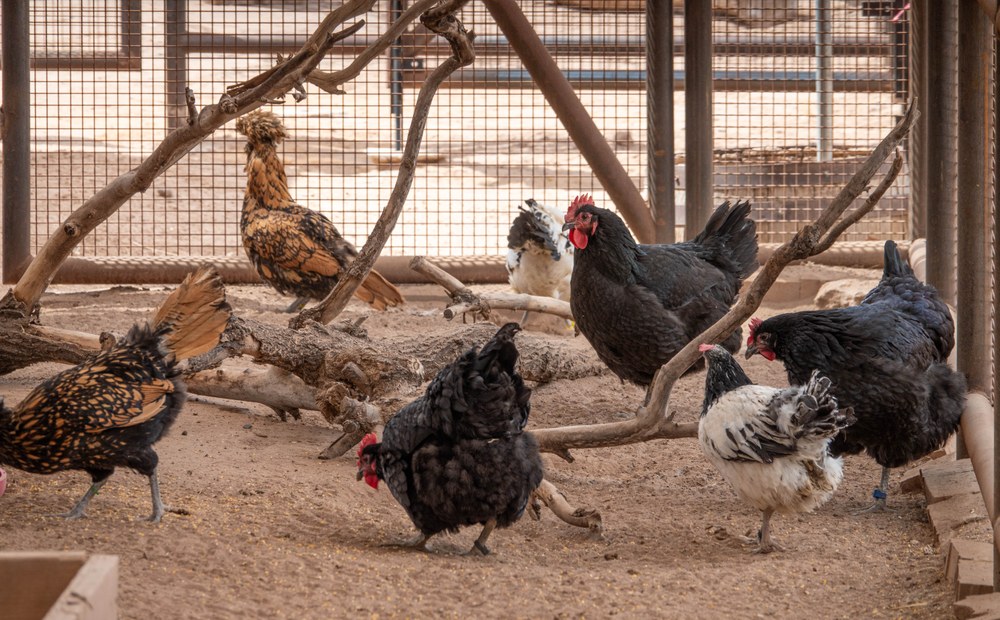
The chickens at Heritage Farm, which include four new breeds, forage for food in their habitat.
